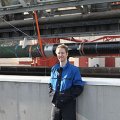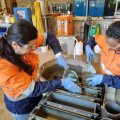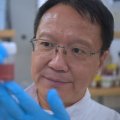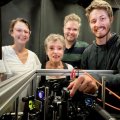Parliamentary Secretary for Innovation and Industry Richard Marles MP visited The University of Queensland today Wednesday July 14, 2010, to meet scientists and inspect progress on a million project to help develop scramjet-based access-to-space systems.
The project, which attracted million funding in the new Australian Space Research Program this year, also is supported by million from an international partnership consortium.
The program will include a free-flying scramjet flight experiment — to be known as SCRAMSPACE I — at the entry point to the scramjet access-to-space speed range, Mach 8 (8600km/hour). The flight experiment will be held in Woomera, South Australia, at this stage in late 2012.
In parallel, scramjet concepts will be tested at even greater speeds — up to Mach 14 — in UQ's world-class hypersonic ground-test facilities.
“No complete scramjet designs have been flight tested at these extreme speeds before now,” said the program director and Chair in Hypersonics at UQ Professor Russell Boyce.
“Most importantly, we will be training young scientists, engineers and students, and creating a talent pool for a future Australian space industry.”
The 13-member international consortium is led by The University of Queensland.
Partners in the program include four Australian universities — UQ, the University of Adelaide, the University of New South Wales, and the University of Southern Queensland; and a US university, the University of Minnesota.
It also includes three international aerospace organisations — DLR in Germany, JAXA of Japan and CIRA of Italy; Australia's Defence Science and Technology Organisation; the Australian Youth Aerospace Association; and industry partners including Brisbane firm Teakle Composites Pty Ltd, Cairns firm AIMTEK Pty Ltd, and BAE Systems Australia.
Professor Boyce said partner agreements had been signed and appointments had been made to the project. Progress had been made on design, layout and flowpath analysis of preliminary concepts, and planning for the flight campaign had begun. This includes two secondary experiments that will fly with the scramjet vehicle – a laser-based flight instrument from UNSW@ADFA, and high temperature materials with embedded sensors from UQ and teakle Composites.
Hardware for upgrading the University’s X3 ground test expansion tube facility had been supplied, as had computer code from the University of Minnesota, which will soon be installed on UQ’s new 3100-core supercomputer.
Four PhD students for the ground testing and computer simulation activities had already been identified.
Professor Boyce will hold discussions this week with the Italian Aerospace Research Center, CIRA, and the German Aerospace center, DLR, concerning their contributions to both the ground and flight test aspects of SCRAMSPACE.
Background
Scramjets are air-breathing engines capable of travelling at hypersonic speeds, greater than Mach 5.
Scramjet-based launch systems promise safe, reliable and economical access to space for launches of communications satellites.
Although scramjet technology has been known since the 1950s, it has proved a hard nut for international scientists to crack.
Australia’s first professor of space engineering, UQ’s Emeritus Professor Ray Stalker began studying scramjets in 1982, his research leading to UQ’s Centre for Hypersonics, one of the world’s largest space engineering University groups.
The Centre, led by Professor Richard Morgan, is involved in research programs with about 20 international universities and research organisations.
A major breakthrough was when a UQ team led by Professor Stalker, Adjunct Professor Allan Paull and Professor David Mee held the world’s first successful ground tests to “fly” a scramjet in 1993 in UQ’s T4 ground test facility.
Professor Paull also led the UQ team which followed ground testing with the world’s first successful scramjet flight experiment, HyShot II, at Woomera, South Australia in 2002.
The engine flew at almost 8000km per hour. (In contrast, a conventional jet plane flies at about 10 times less that speed — 800km per hour.)
The University has since partnered with groups such as the Defence Science and Technology Organisation, which has opened an office in Brisbane as part of the Air Vehicles Division.
Australia has now hosted six scramjet flights, and further experiments to test the technology in the million HiFIRE series are being held at Woomera in the next few years.
Much of the University’s success is based on staff and student innovations, and its unique ground test facilities.
The T4 tunnel and the X-tubes in UQ’s Centre for Hypersonics are ideal for testing flight at very high speeds. They are widely used by international space organisations such as NASA, in the US; the German Aerospace Center, DLR; and Japanese Aerospace Exploration Agency, JAXA.
The University also has its own rocket launcher at Woomera, a gift from JAXA.
Media: Jan King, UQ, 0413 601 248

.jpg)









